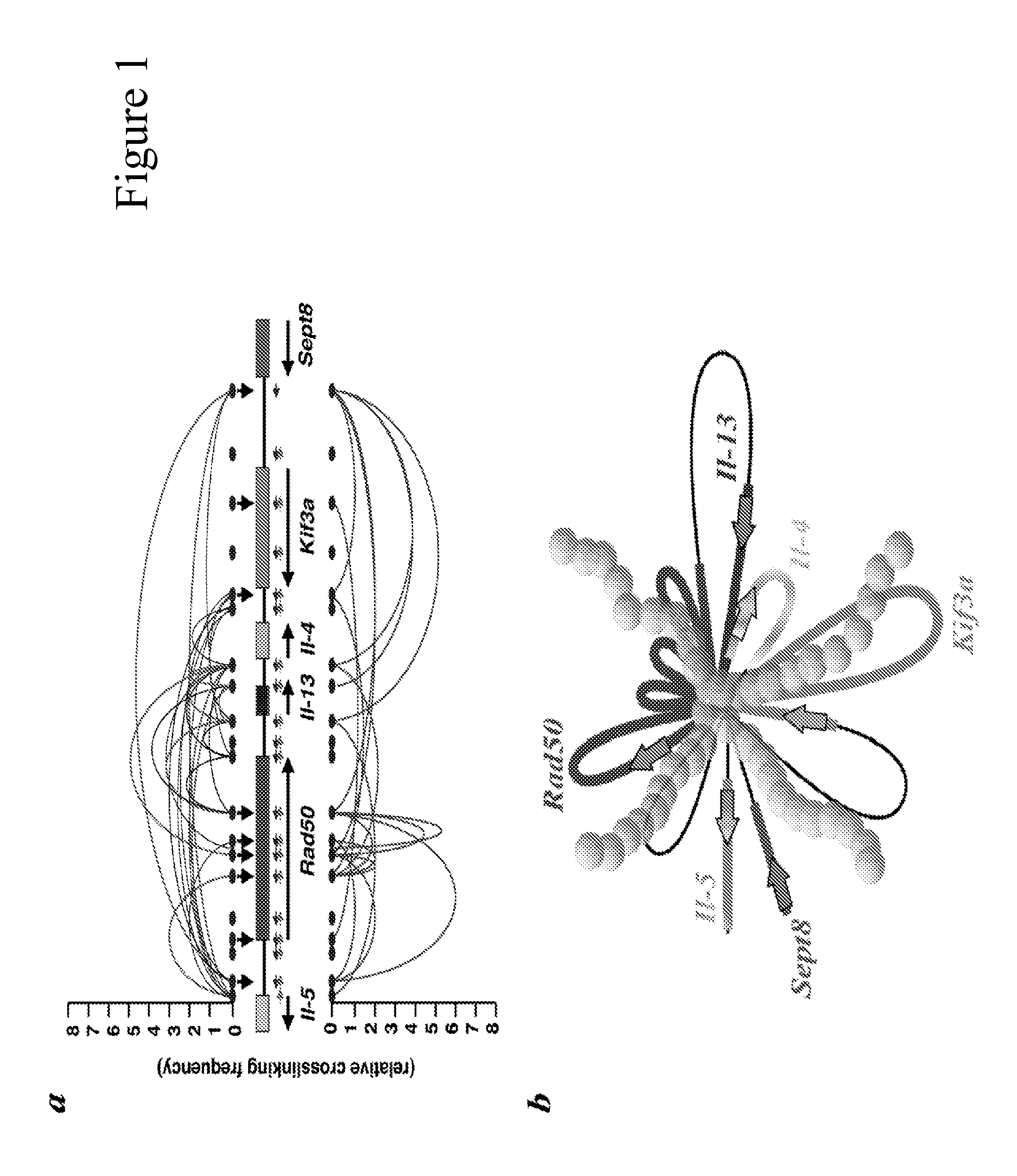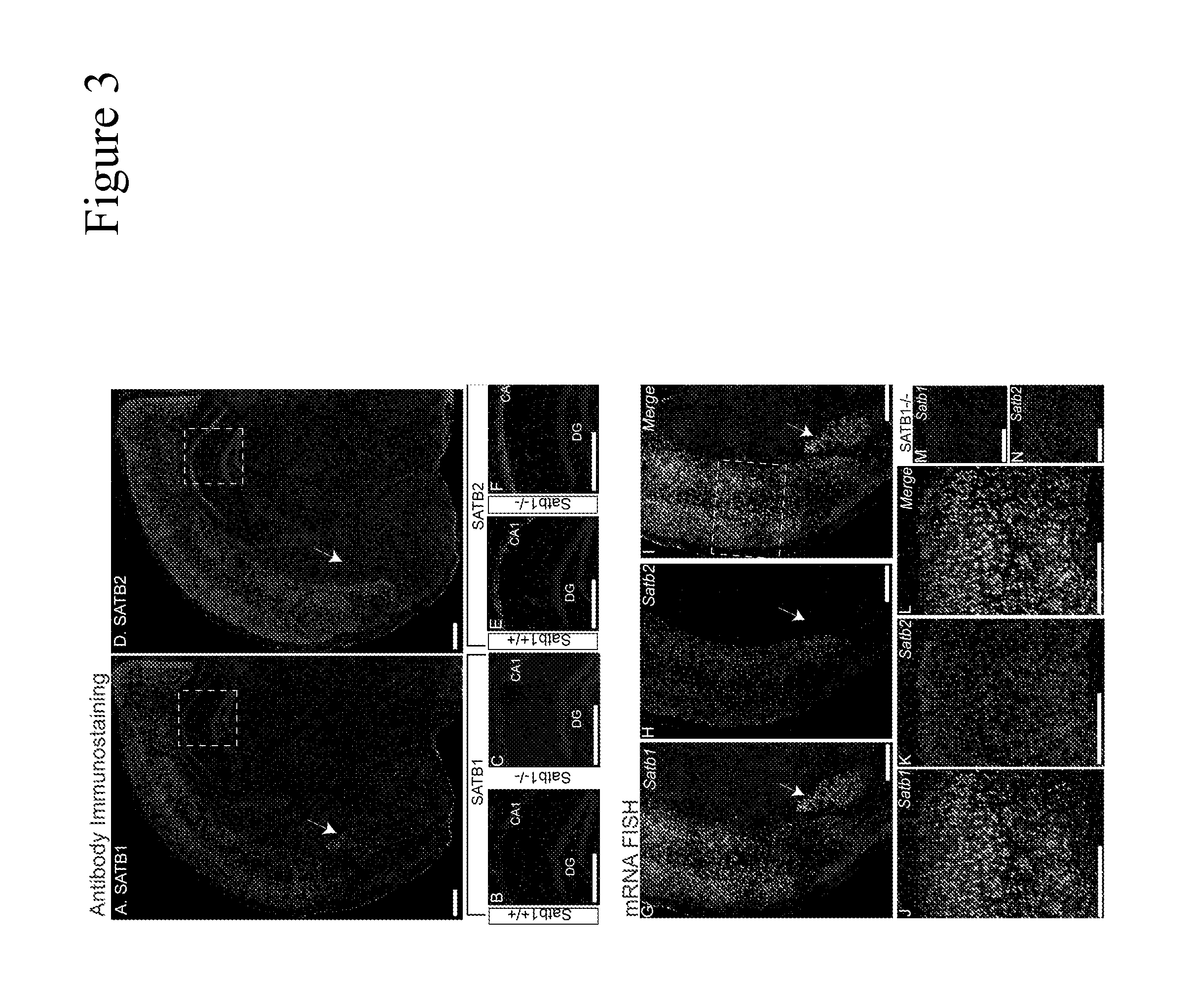Potential Prognostic Markers and Therapeutic Targets for Neurological Disorders
a neurological disorder and prognostic marker technology, applied in the field of neurological disorders, can solve the problems of still poorly understood how different subsets of creb target genes are affected, and achieve the effect of confirmating the association and causative effect of satb1 depletion
- Summary
- Abstract
- Description
- Claims
- Application Information
AI Technical Summary
Benefits of technology
Problems solved by technology
Method used
Image
Examples
example 1
SATB1 and / or SATB2 Expression in Mature Neurons in Postnatal Brain Subregions
[0277]To study the role of SATB1 in postnatal mouse brain, we first determined the expression patterns of SATB1 as well as SATB2 in the coronal sections of P13 wild-type mouse brain, using immunostaining and mRNA in situ hybridization (mRNA FISH) methods.
[0278]We employed antibody specific for SATB1 (FIG. 3A) or SATB2 (FIG. 3D). Sections of SATB1 knockout mouse brain were used to confirm the specificity of anti-SATB1 antibody (FIG. 3C). In wild type brain, we detected strong and widely distributed SATB1-specific signals in the cortex and amygdala (FIG. 3A). Additionally, some hilar cells in the dentate gyms (DG) and some cells in radial and stratum oriens layers of the hippocampus expressed SATB1 (FIGS. 3A, 3B). We also detected weak signals in some cells in hypothalamus (FIG. 3A). Within the amygdala, SATB1 was most abundantly expressed in the lateral and medial (indicated with arrow on FIG. 1A), but to a ...
example 2
Identification of Genes Regulated by SATB1 in Postnatal Brain
[0284]Expression microarray analysis was used to compare the global gene expression patterns between wild type and SATB1-null mouse brains. Total RNA from 3 different P13 knockout and wild type littermate cortexes was extracted and individually subjected to Affymetrix array hybridization. A total of 109 genes were significantly altered by more than 1.4 fold between SATB1-null and wild type samples(p-value <0.05, 38 (35%) genes down-regulated and 71 (65%) up-regulated by SATB1). A representative gene list is shown (FIG. 6A, a full list of genes is not shown). Using the National Institutes of Health's DAVID software, the genes (p-value <0.05 and fold change ≧1.3) were classified into Gene Ontology (GO) categories. Interestingly, genes up-regulated by SATB1 are enriched in genes involved in transcription and in neuronal activity and development, while SATB1 downregulated genes are significantly represented by transport, cell ...
example 3
cAMP-Responsive Genes are Dysregulated in SATB1-Null Cortex
[0293]The expression of immediate early genes is regulated by secondary messenger such as cAMP and Ca2+. To study the effect of SATB1 on activity-dependent response of the brain, we set out to study cAMP / Ca2+ pathway related gene expression in depth. We used the RT2 Profiler™ PCR Array, a commercially available qRT-PCR array, that contained primer sets of 84 different genes known to be regulated by cAMP or Ca2+ and multiple control genes for normalization. We first compared mRNA expression in 13 day old SATB1-null cortex with the wild-type cortex and found 10 genes either significantly up or down regulated (Table 1). This data indicates that in addition to immediate early genes SATB1 also regulates many other cAMP-responsive genes.
PUM
| Property | Measurement | Unit |
|---|---|---|
| temperatures | aaaaa | aaaaa |
| temperatures | aaaaa | aaaaa |
| temperatures | aaaaa | aaaaa |
Abstract
Description
Claims
Application Information
 Login to View More
Login to View More - R&D
- Intellectual Property
- Life Sciences
- Materials
- Tech Scout
- Unparalleled Data Quality
- Higher Quality Content
- 60% Fewer Hallucinations
Browse by: Latest US Patents, China's latest patents, Technical Efficacy Thesaurus, Application Domain, Technology Topic, Popular Technical Reports.
© 2025 PatSnap. All rights reserved.Legal|Privacy policy|Modern Slavery Act Transparency Statement|Sitemap|About US| Contact US: help@patsnap.com



